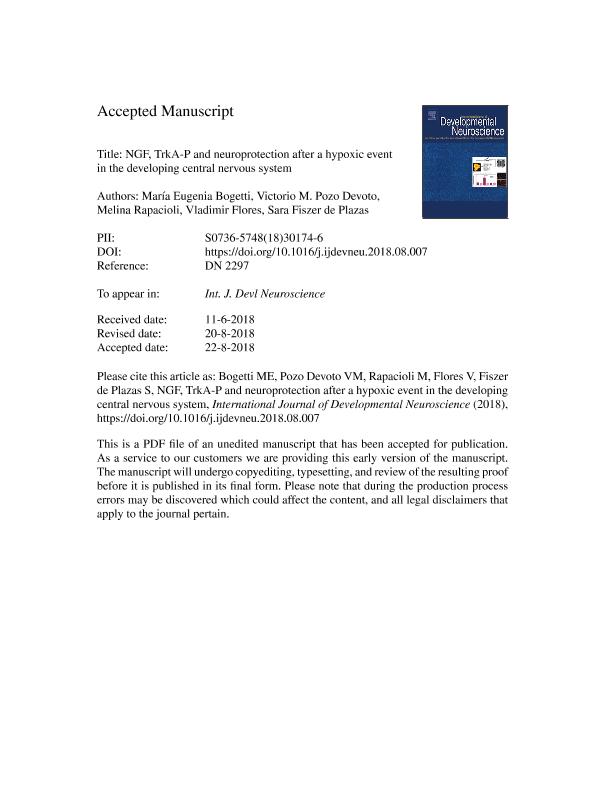Mostrar el registro sencillo del ítem
dc.contributor.author
Bogetti, María Eugenia
dc.contributor.author
Pozo Devoto, Victorio Martin

dc.contributor.author
Rapacioli, Melina

dc.contributor.author
Flores, Domingo Vladimir

dc.contributor.author
Fiszer de Plazas, Sara
dc.date.available
2020-03-12T21:13:43Z
dc.date.issued
2018-12
dc.identifier.citation
Bogetti, María Eugenia; Pozo Devoto, Victorio Martin; Rapacioli, Melina; Flores, Domingo Vladimir; Fiszer de Plazas, Sara; NGF, TrkA-P and neuroprotection after a hypoxic event in the developing central nervous system; Pergamon-Elsevier Science Ltd; International Journal of Developmental Neuroscience; 71; 1; 12-2018; 111-121
dc.identifier.issn
0736-5748
dc.identifier.uri
http://hdl.handle.net/11336/99409
dc.description.abstract
A decrease in the concentration of oxygen in the blood and tissues (hypoxia) produces important, sometimes irreversible, damages in the central nervous system (CNS) both during development and also postnatally. The present work aims at analyzing the expression of nerve growth factor (NGF) and p75 and the activation of TrkA in response to an acute normobaric hypoxic event and to evaluate the possible protective role of exogenous NGF. The developing chick optic tectum (OT), a recognized model of corticogenesis, was used as experimental system by means of in vivo and in vitro studies. Based on identification of the period of highest sensitivity of developmental programmed cell death (ED15) we show that hypoxia has a mild but reproducible effect that consist of a temporal increase of cell death 6 h after the end of a hypoxic treatment. Cell death was preceded by a significant early increase in the expression of Nerve Growth Factor (NGF) and its membrane receptor p75. In addition, we found a biphasic response of TrkA activation: a decrease during hypoxia followed by an increase −4 h later- that temporally coincide with the interval of NGF overexpression. To test the NGF - NGF receptors role in hypoxic cell death, we quantified, in primary neuronal cultures derived from ED15 OT, the levels of TrkA activation after an acute hypoxic treatment. A significant decline in the level of TrkA activation was observed during hypoxia followed, 24 h later, by significant cell death. Interestingly, this cell death can be reverted if TrkA inactivation during hypoxia is suppressed by the addition of NGF. Our results suggest that TrkA activation may play an important role in the survival of OT neurons subjected to acute hypoxia. The role of TrkA in neuronal survival after injury may be advantageously used for the generation of neuroprotective strategies to improve prenatal insult outcomes.
dc.format
application/pdf
dc.language.iso
eng
dc.publisher
Pergamon-Elsevier Science Ltd

dc.rights
info:eu-repo/semantics/openAccess
dc.rights.uri
https://creativecommons.org/licenses/by-nc-sa/2.5/ar/
dc.subject
ACUTE HYPOXIA
dc.subject
CELL DEATH
dc.subject
NEUROPROTECTION
dc.subject
NEUROTROPHIN
dc.subject
OPTIC TECTUM
dc.subject.classification
Biología del Desarrollo

dc.subject.classification
Ciencias Biológicas

dc.subject.classification
CIENCIAS NATURALES Y EXACTAS

dc.title
NGF, TrkA-P and neuroprotection after a hypoxic event in the developing central nervous system
dc.type
info:eu-repo/semantics/article
dc.type
info:ar-repo/semantics/artículo
dc.type
info:eu-repo/semantics/publishedVersion
dc.date.updated
2020-03-05T14:56:24Z
dc.journal.volume
71
dc.journal.number
1
dc.journal.pagination
111-121
dc.journal.pais
Estados Unidos

dc.journal.ciudad
Amsterdam
dc.description.fil
Fil: Bogetti, María Eugenia. Consejo Nacional de Investigaciones Científicas y Técnicas. Oficina de Coordinación Administrativa Houssay. Instituto de Biología Celular y Neurociencia "Prof. Eduardo de Robertis". Universidad de Buenos Aires. Facultad de Medicina. Instituto de Biología Celular y Neurociencia; Argentina
dc.description.fil
Fil: Pozo Devoto, Victorio Martin. Consejo Nacional de Investigaciones Científicas y Técnicas. Oficina de Coordinación Administrativa Houssay. Instituto de Biología Celular y Neurociencia "Prof. Eduardo de Robertis". Universidad de Buenos Aires. Facultad de Medicina. Instituto de Biología Celular y Neurociencia; Argentina
dc.description.fil
Fil: Rapacioli, Melina. Consejo Nacional de Investigaciones Científicas y Técnicas. Oficina de Coordinación Administrativa Houssay. Instituto de Neurociencia Cognitiva. Fundación Favaloro. Instituto de Neurociencia Cognitiva; Argentina
dc.description.fil
Fil: Flores, Domingo Vladimir. Consejo Nacional de Investigaciones Científicas y Técnicas. Oficina de Coordinación Administrativa Houssay. Instituto de Neurociencia Cognitiva. Fundación Favaloro. Instituto de Neurociencia Cognitiva; Argentina. Consejo Nacional de Investigaciones Científicas y Técnicas. Oficina de Coordinación Administrativa Houssay. Instituto de Biología Celular y Neurociencia "Prof. Eduardo de Robertis". Universidad de Buenos Aires. Facultad de Medicina. Instituto de Biología Celular y Neurociencia; Argentina
dc.description.fil
Fil: Fiszer de Plazas, Sara. Consejo Nacional de Investigaciones Científicas y Técnicas. Oficina de Coordinación Administrativa Houssay. Instituto de Biología Celular y Neurociencia "Prof. Eduardo de Robertis". Universidad de Buenos Aires. Facultad de Medicina. Instituto de Biología Celular y Neurociencia; Argentina
dc.journal.title
International Journal of Developmental Neuroscience

dc.relation.alternativeid
info:eu-repo/semantics/altIdentifier/doi/https://doi.org/10.1016/j.ijdevneu.2018.08.007
dc.relation.alternativeid
info:eu-repo/semantics/altIdentifier/url/https://onlinelibrary.wiley.com/doi/full/10.1016/j.ijdevneu.2018.08.007
Archivos asociados
